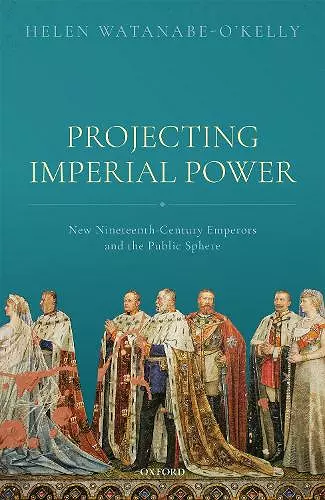Projecting Imperial Power
New Nineteenth Century Emperors and the Public Sphere
Format:Hardback
Publisher:Oxford University Press
Published:9th Jul '21
Currently unavailable, and unfortunately no date known when it will be back

The nineteenth century is notable for its newly proclaimed emperors, from Franz I of Austria and Napoleon I in 1804, through Agustín of Mexico, Pedro I of Brazil, Napoleon III of France, Maximilian of Mexico, and Wilhelm I of Germany, to Victoria, empress of India, in 1876. These monarchs projected an imperial aura through coronations, courts, medals, costumes, portraits, monuments, international exhibitions, festivals, religion, architecture, and town planning. They relied on ancient history for legitimacy while partially espousing modernity. Projecting Imperial Power is the first book to consider together these newly proclaimed emperors in six territories on three continents across the whole of the long nineteenth century. The first emperors' successors—Pedro II of Brazil, Franz Joseph of Austria, and Wilhelm II of Germany—expanded their panoply of power, until Pedro was forced to abdicate in 1889 and the First World War brought the Austrian and German empires to an end. Britain invented an imperial myth for its Indian empire in the twentieth century, but George VI still had to relinquish the title of emperor in 1947. Using a wide range of sources, Projecting Imperial Power explains the imperial ambition behind the cities of Berlin, Paris, Vienna, and New Delhi. It discusses the contested place of the emperors and their empires in national cultural memory by examining how the statues that were erected in huge numbers in the second part of the period are treated today.
This ground-breaking study is the first, as the book's blurb states, "to consider together these newly proclaimed emperors in six territories on three continents across the whole of the long nineteenth-century." The author draws upon a wealth of written sources and offers a multifaceted approach, exploring how these monarchs projected an imperial aura through courts, honours, coronations, city planning, and much more. This absorbing book brings new perspectives to key themes in the history of emperorship. * Aidan Jones, King's College London, Royal Studies Journal *
The narrative strength of the book lies in its presentation of the visual power of imperial ceremonies such as emperors' coronations, their portraits, narratives, architectures, and acts of commemoration in Europe, South America, and India. * Jana Osterkamp, Ludwig Maximilian University, Munich, Germany *
ISBN: 9780198802471
Dimensions: 242mm x 163mm x 26mm
Weight: 696g
360 pages